Introducing a cone, also known as an Elizabethan collar or E-collar, to your dog can be a necessary precaution after surgery or to prevent them from aggravating an injury.
Combining the use of a cone with crating your dog might seem like a challenging endeavor, but it is possible with the right approach and considerations.
In this article, we will explore whether a dog can wear a cone while in a crate, as well as provide tips and guidelines for ensuring the comfort and safety of your furry companion during this challenging period.
- Why Do Dogs Need to Wear Cones?
- Can Dog Wear Cone in Crate
- What Are the Different Types of Dog Cones?
- Can a Dog Sleep in a Crate With a Cone?
- Can I Safely Crate a Coned Dog?
- What Is the Best Way to Make a Dog Sleep in a Crate With a Cone?
- Can I Leave My Dog Alone With a Cone On?
- Is It Okay To Leave a Dog in a Crate With a Cone On?
- How Long Should a Dog Wear a Cone After Surgery?
- The Benefits of Cones for Dogs
- Benefits of Crates for Dogs
- FAQs
- In Conclusion
Key Takeaway
- Dogs need to wear cones to prevent them from licking, scratching, or biting at wounds, surgical incisions, or irritations, thereby ensuring proper healing and preventing infections.
- A dog can wear a cone in a crate as long as the crate is large enough to accommodate the extra space the cone requires without causing discomfort or restriction to the dog’s movement.
- A dog can sleep in a crate with a cone on, as long as the crate is spacious enough to accommodate the cone without causing discomfort or restricting the dog’s movement.
Can Dog Wear Cone in Crate
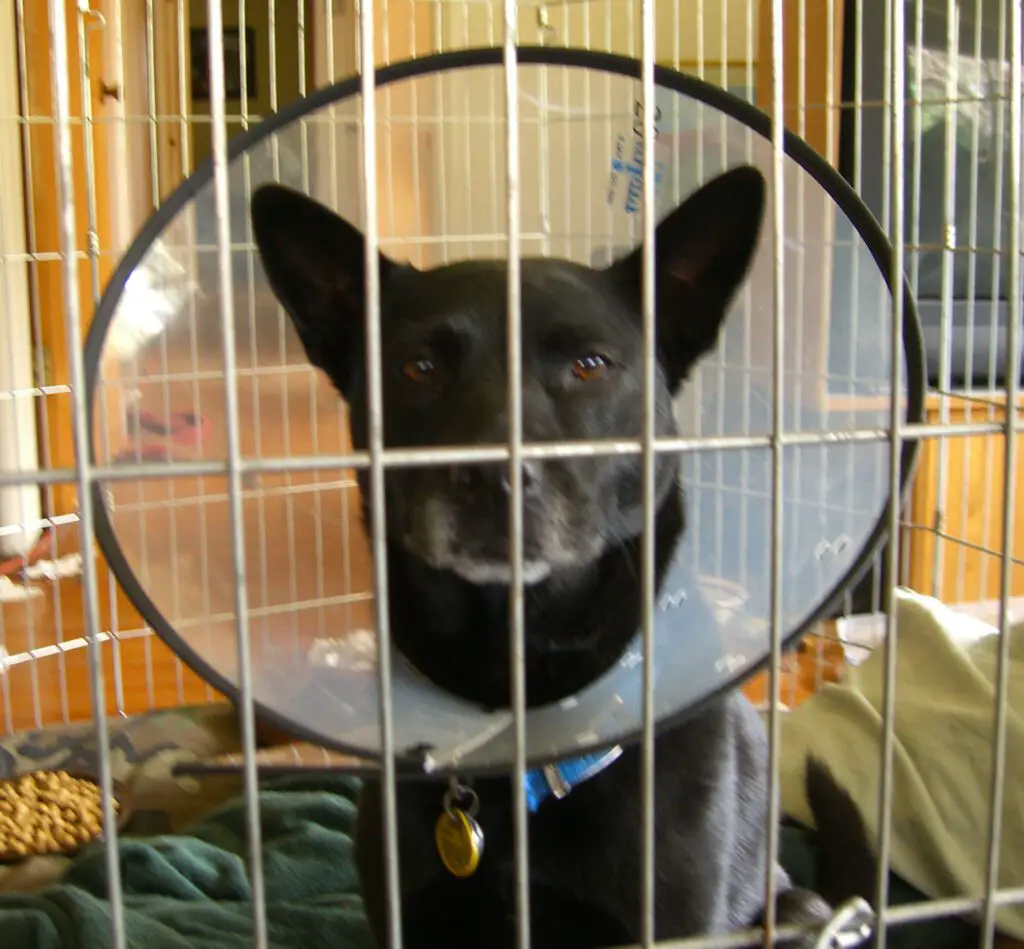
Yes, a dog can wear a cone in a crate, provided the crate is spacious enough to comfortably accommodate the dog and the cone without restricting movement or causing discomfort.
If a dog is wearing a cone in a crate, it may have trouble turning around, sitting, or laying down, which can make the crate uncomfortable for them.
Additionally, if a dog gets their cone caught on any part of the crate, it can cause them to panic and potentially harm themselves.
If it is necessary to leave a dog in a crate while they are wearing a cone, it is important to ensure that it is properly fitted and that there is enough clearance for the cone to move around without getting caught on the crate.
Providing a comfortable and secure environment for the dog is key to keeping them safe and stress-free while wearing a cone in a crate.
Why Do Dogs Need to Wear Cones?
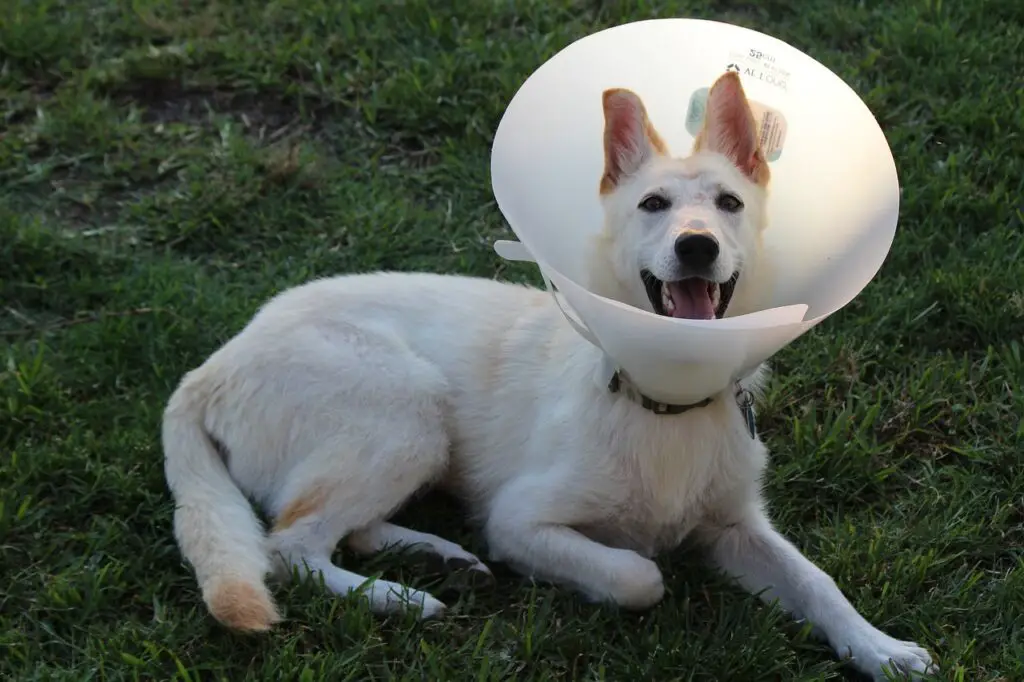
Dogs need to wear cones, also known as Elizabethan collars or E-collars, primarily to prevent them from licking, biting, or scratching at wounds or surgical sites, thus promoting healing and preventing complications.
Protection of Wounds and Injuries
One of the primary reasons I recommend cones for dogs in my veterinary practice is to protect wounds and injuries.
Dogs instinctively lick and chew at their wounds, which can delay healing and introduce bacteria, leading to infections. A cone effectively prevents this by creating a barrier between the dog’s mouth and the wound.
Prevention of Chewing on Bandages or Stitches
Another crucial use of cones is to prevent dogs from chewing on bandages or stitches after surgery or injury treatment. In my experience, many dogs find these foreign materials irritating and will attempt to remove them if given the chance.
A cone deters this behavior, ensuring that the stitches or bandages stay intact and the healing process isn’t disrupted.
Comfort and Support
While it may not seem like it initially, cones can provide comfort and support for dogs. They can prevent further injury by stopping a dog from scratching an itchy ear with a back paw or rubbing a sensitive eye.
As a vet, I’ve seen numerous instances where a cone has helped a dog heal faster and more comfortably by preventing these potentially harmful behaviors.
Easy to Use
Finally, cones are straightforward and easy to use, making them a practical solution for most dog owners.
They’re typically adjustable to fit snugly around the dog’s neck and can be quickly removed and reattached as needed, such as during meal times or when the dog needs a break as per Wikipedia.
In my practice, I always ensure owners know how to properly fit and use a cone before sending them home with one.
What Are the Different Types of Dog Cones?
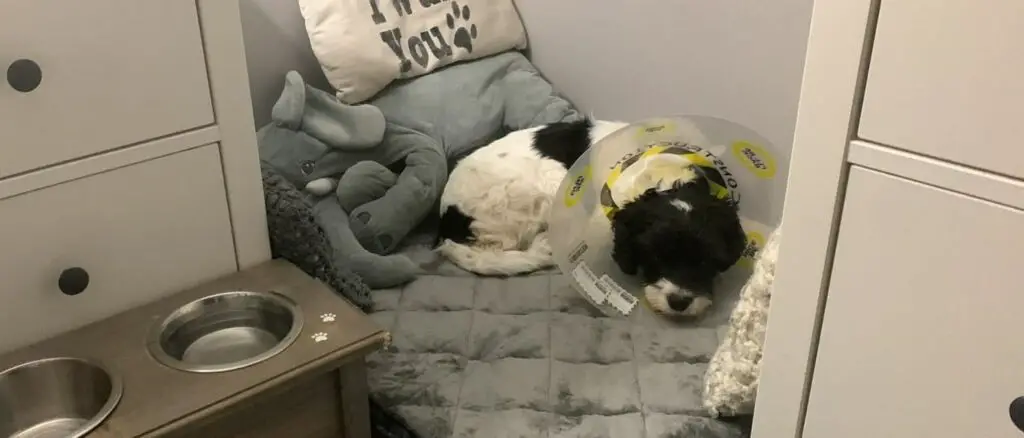
Dog cones, also known as Elizabethan collars or E-collars, are designed to prevent dogs from licking, biting, or scratching wounds, surgical sites, or irritated skin.
There are various types of dog cones available, each with its advantages and disadvantages. Here are some of the different types of dog cones:
1. Traditional Plastic Cones
Traditional plastic cones are the most common type of dog cone. They are made from hard plastic and have a cone shape that extends around the dog’s head. These cones are durable, easy to clean, and relatively inexpensive. However, they can be uncomfortable for some dogs and may impede their movement or vision.
2. Soft Cones
Soft cones are made from flexible, padded materials like foam, fabric, or inflatable rings. These cones are more comfortable for dogs to wear and less likely to cause injury when bumping into objects or people.
Soft cones are suitable for dogs with sensitive skin or those that need to wear the cone for an extended period. However, they may not be as effective at preventing licking or chewing in some cases, and they might be less durable than traditional plastic cones.
3. Inflatable Cones
Inflatable cones, also known as inflatable collars, are circular devices that fit around the dog’s neck like a cushion or travel pillow. These cones are more comfortable for dogs to wear and allow for better mobility and vision.
Inflatable cones are suitable for dogs that are prone to anxiety or stress when wearing traditional cones. However, they may not provide enough protection for certain types of injuries or surgical sites and may be easier for determined dogs to remove.
4. Bite-Not Collars
Bite-Not collars are a unique type of dog cone that resembles a neck brace. These collars restrict the dog’s head movement, making it difficult for them to reach their wounds or surgical sites.
Bite-Not collars are more comfortable for dogs to wear and allow for better mobility and vision than traditional cones. However, they may not be suitable for all types of injuries or dogs, and some pets may still find ways to reach their wounds.
Top pick
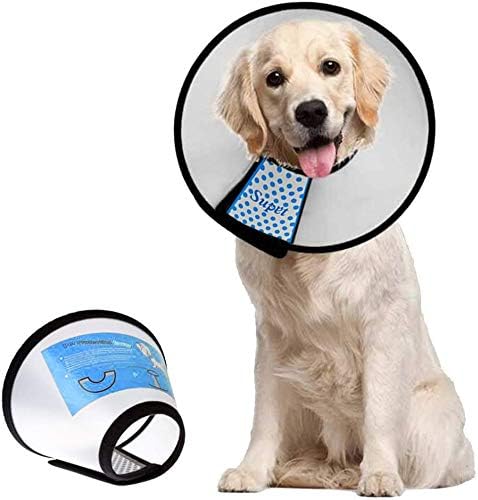
Supet Dog Cone
Great cone collar that is safe and suitable for different ages and sizes.
Editor’s choice
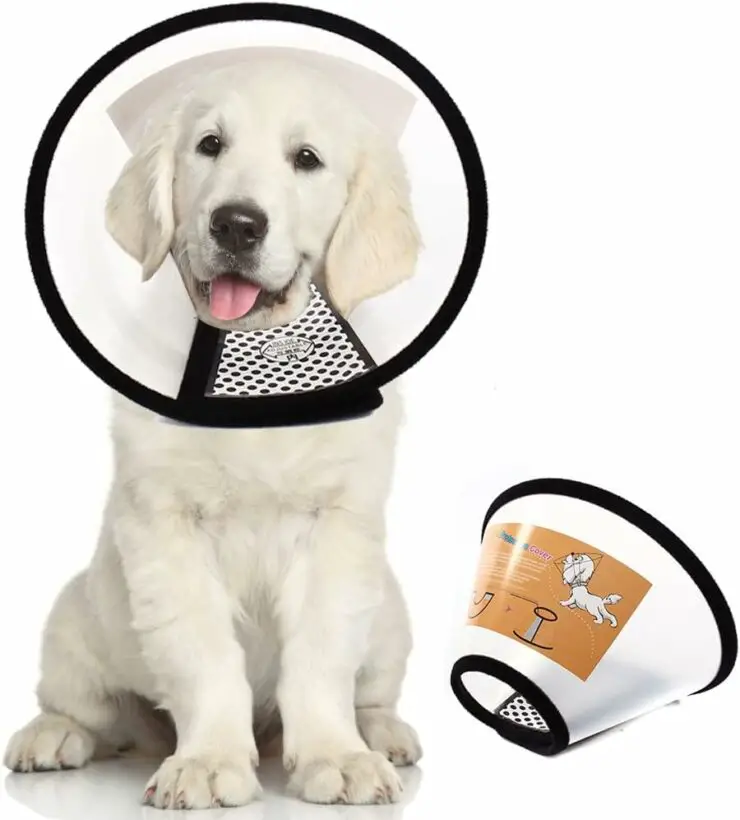
QIYADIN Plastic Pet Recovery Collars
Made out of high-quality material that is durable, yet easy to use.
Best value
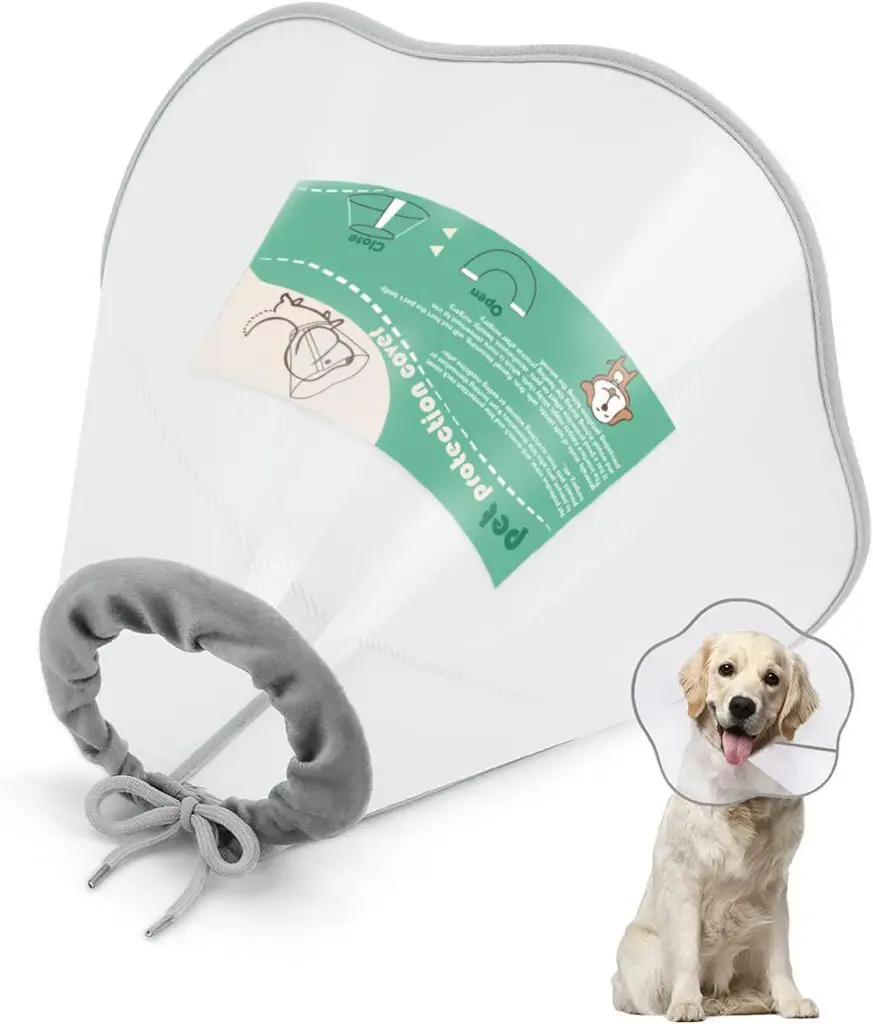
Adjustable Pet Recovery Collar
Unique dog collar with patented design safe for dogs that are sleeping in crates.
Can a Dog Sleep in a Crate With a Cone?
Yes, a dog can sleep in a crate with a cone but you will need to take some precautions to ensure their safety and comfort.
Firstly, you will need to make sure that the crate is large enough for your dog and provides them with enough room to move around comfortably, even with the cone on.
Secondly, you will need to remove any toys or bedding that could get stuck in the cone or interfere with their ability to move around.
It’s also worth considering whether your dog can still access their food and water with the cone on. If not, you may need to take the cone off during meal times or provide them with a special feeding bowl that can accommodate the cone.
Finally, you should check on your dog regularly to make sure that they are comfortable and that the cone is still in place. If your dog is in obvious distress or the cone has come loose, you should remove it immediately and seek veterinary advice.
Overall, with a little bit of preparation and some extra care, your dog can still sleep in their crate with a cone – just make sure that they have enough space, can access their food and water, and are checked on regularly.
Can I Safely Crate a Coned Dog?
Yes, you can safely crate a coned dog, but it’s important to take a few precautions to avoid further injury.
Firstly, choose a crate that is large enough for your dog to comfortably move around in without their cone getting caught or bumped.
Second, ensure that the cone fits properly and doesn’t rub against the crate walls. If your dog is experiencing discomfort with the cone, talk to your vet about alternative options.
Thirdly, consider covering sharp edges or corners inside the crate with blankets or towels to prevent accidental poking or scraping of the cone.
Lastly, monitor your dog closely while crated to ensure they aren’t attempting to break free or causing themselves further injury.
How to Make a Dog Comfortable When Sleeping with a Cone
Making a dog comfortable when sleeping with a cone involves several strategies, such as providing a larger sleeping space, softening the cone, adjusting bedding, and offering mental stimulation.
Provide a Larger Sleeping Space
In my veterinary practice, one piece of advice I often give to pet owners is to provide a larger sleeping space for dogs wearing a cone.
This is because the cone increases their overall size and they may need more room to find a comfortable position. A larger bed or a spacious area on the floor can make a significant difference in their comfort level.
Soften the Cone
Another useful strategy is to soften the cone if it’s stiff. This can be done by gently rolling and folding it, which can make it more pliable and comfortable against the dog’s neck and shoulders.
I’ve found this technique particularly helpful for dogs that are initially uncomfortable or distressed with the cone.
Adjust Bedding
Adjusting your dog’s bedding can also help them sleep comfortably with a cone. In some cases, pets find it easier to rest their head on a slightly elevated surface while wearing the cone.
Placing a soft pillow or folded blanket under their head can provide this additional comfort.
Offer Mental Stimulation
Lastly, keeping your dog mentally stimulated can help distract them from the discomfort of the cone. Short training sessions, puzzle toys, or gentle play can help take their mind off the cone.
As a vet, I’ve seen how effective these distractions can be in helping dogs adjust to wearing a cone, especially during the initial period.
Is It Okay To Leave a Dog in a Crate With a Cone On?
Leaving a dog in a crate with a cone on is generally safe and acceptable, as long as the cone is appropriately fitted and secured.
A cone is commonly used to prevent a dog from licking or biting at a wound or surgical incision.
It is essential to follow the veterinarian’s instructions on how long a dog should wear the cone.
While in a crate, a cone can help prevent a dog from scratching at the crate door or walls and injuring themselves.
However, it is crucial to ensure that the crate is appropriately sized for the dog and that the dog has sufficient space to stand up, lay down, and turn around comfortably.
Providing the dog with water and appropriate toys can also help keep them comfortable and entertained while in the crate.
It is also essential to note that dogs should not be left in a crate for extended periods. Prolonged confinement can lead to physical and psychological health issues, such as obesity and anxiety.
In summary, it is okay to leave a dog in a crate with a cone on it as long as adequate precautions are taken and pet owners follow the vet’s guidelines.
However, proper crate size, limiting confinement time, and providing necessary care and attention are key to ensuring the dog’s well-being says Dogs and Clogs.
How Long Should a Dog Wear a Cone After Surgery?
In most cases, the cone should be worn for at least 2 weeks following the procedure to prevent the dog from removing stitches or irritating the site.
Some surgeries may require longer wear time such as if the surgical site is in a difficult-to-reach location and the healing process is slower.
However, it is important to keep a close eye on your dog’s behavior and the condition of the incision site. Consult with your veterinarian if you notice any signs of infection or abnormal activity.
If your dog continues to lick or chew at the site even with the cone on, an additional restrictive garment such as a velcro vest can be used.
Proper use of the cone can greatly improve the healing process for your dog. They ensure that they make a full and speedy recovery.
The Benefits of Cones for Dogs
Cones, also known as e-collars or recovery collars, are a common tool used to protect dogs from licking or scratching wounds, surgical incisions, or other skin irritations. They can be made of plastic or fabric and come in a variety of sizes to fit any dog. Here are some of the benefits of using cones for dogs:
Prevents Infection
Using a cone on your dog can help prevent infection by keeping them from licking or scratching their wound. This is especially important after surgery, as it can help the healing process and reduce the risk of complications.
Comfort and Safety
Cones provide comfort and safety for your pet by limiting their movement and protecting them from further injury. Many cones are adjustable so you can customize the fit for your dog’s size and shape. Some even have soft edges to prevent rubbing against your pet’s skin.
Easy to Use
Cones are easy to use and don’t require any special training or knowledge. Most come with instructions on how to properly put them on your pet. Many have straps that make it easier to secure the cone in place. Additionally, there are now alternatives to traditional cones such as inflatable collars that provide similar protection without being as intrusive.
Benefits of Crates for Dogs
Crates can provide numerous benefits for dogs and their owners when used responsibly and appropriately. Here are some of the advantages that crates can offer:
Benefit 1: Safe Space and Den-Like Environment
Crates can serve as a safe and comfortable den-like space for your dog, offering a sense of security and familiarity. When properly introduced and associated with positive experiences, crates can become a place where your dog feels relaxed and at ease.
Benefit 2: House Training Tool
Crates can be an effective tool for house-training puppies and adult dogs. By establishing a consistent routine and leveraging the dog’s natural instinct to keep their den clean, crate training can help teach your dog to eliminate outside and maintain good habits indoors.
Benefit 3: Travel Safety
Crates can provide a safe and secure environment for dogs during travel, whether by car or airplane. Ensuring your dog is safely contained in a crate can minimize the risk of injury during transit and reduce stress for both you and your pet.
Benefit 4: Management of Separation Anxiety
For dogs with mild separation anxiety, crates can offer a secure space where they feel safe when left alone. However, it is crucial to address the root cause of separation anxiety through behavior modification. If necessary, consult with a professional dog trainer or veterinarian for guidance.
Benefit 5: Prevent Destructive Behavior
Crates can be useful in preventing destructive behavior by limiting your dog’s access to items and areas of your home when unsupervised. This not only protects your belongings but also ensures your dog’s safety by reducing the risk of ingesting harmful objects.
FAQs
1. Can a dog wear a cone in a crate?
Yes, a dog can wear a cone in a crate if necessary. However, it is important to consider whether the cone is safe and comfortable for the dog during this time.
2. Is it safe for a dog to sleep with a cone?
While it is generally safe for a dog to sleep with a cone, it may not be the most comfortable option for them. Using a soft cone or comfortable alternative may be more appropriate for a dog to sleep in its crate.
3. Can I leave my dog alone with a cone on?
It is not recommended to leave your dog alone with a cone on as they may become stressed or anxious. If it is necessary to leave a dog alone, it is important to ensure that they are comfortable and safe.
4. How can I make my dog more comfortable with a cone on?
To make a dog comfortable with a cone on, it is important to help your dog adjust to wearing it gradually. Offering treats and positive reinforcement when the dog is wearing the cone can help. Using a soft cone or comfortable alternative may also be a good option.
5. Can a dog wear a collar and a cone?
It is not recommended to have a dog wear a collar and a cone at the same time. This may cause discomfort or injury. It is best to consult with a veterinarian to determine the best course of action for your dog.
6. Can a dog sleep in a crate with a cone on?
Yes, a dog can sleep in their crate with a cone on it if necessary. However, it is important to ensure that the dog is comfortable and safe. Using a soft cone or comfortable alternative may help ensure that the dog has a better night’s sleep. Additionally, it is important to check the cone and any other items in the crate regularly to make sure they are not causing any discomfort or irritation.
Conclusion and final thoughts
It is possible for a dog to wear a cone while in a crate, provided that certain precautions and adjustments are made to ensure the pet’s comfort and safety.
This includes selecting an appropriately sized crate with enough space for the dog to move comfortably while wearing the cone and monitoring your pet closely to prevent any complications.
Remember that the cone and crate are temporary measures aimed at protecting your dog’s health and promoting healing.
By being attentive, patient, and supportive during this period, you can help your furry friend adjust and recover more smoothly.





Leave a Reply